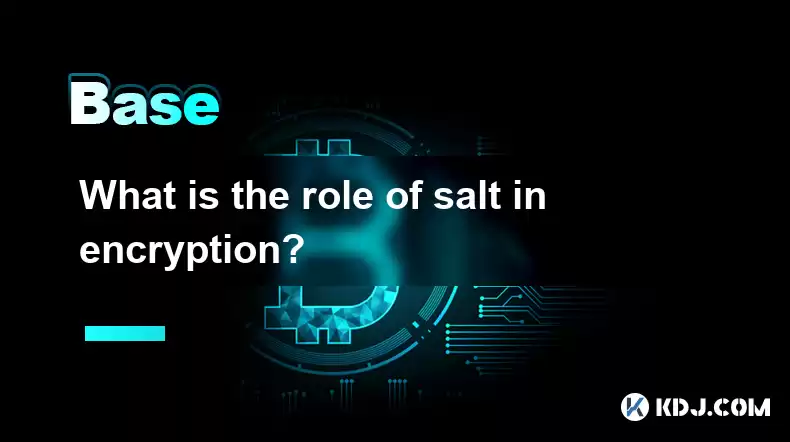-
 bitcoin
bitcoin $109523.663807 USD
-0.13% -
 ethereum
ethereum $4019.526508 USD
2.06% -
 tether
tether $1.000482 USD
0.00% -
 xrp
xrp $2.776815 USD
0.18% -
 bnb
bnb $958.942396 USD
0.12% -
 solana
solana $204.294698 USD
3.84% -
 usd-coin
usd-coin $0.999693 USD
0.00% -
 dogecoin
dogecoin $0.232115 USD
2.09% -
 tron
tron $0.338028 USD
0.84% -
 cardano
cardano $0.790920 USD
1.50% -
 hyperliquid
hyperliquid $44.871443 USD
5.60% -
 ethena-usde
ethena-usde $1.000322 USD
0.04% -
 chainlink
chainlink $21.034165 USD
2.60% -
 avalanche
avalanche $28.794831 USD
-0.54% -
 stellar
stellar $0.360466 USD
1.24%
What is the role of salt in encryption?
Cryptographic salts, random strings added to passwords before hashing, dramatically improve security by preventing rainbow table attacks. Unique salts for each password are crucial, requiring at least 128 bits for optimal protection against brute-force attempts.
Mar 05, 2025 at 02:24 am

- Salt's primary function in cryptography is to enhance the security of password hashing algorithms.
- It adds randomness to the hashing process, making it significantly harder for attackers to crack passwords even if they possess the same hashing algorithm and a database of hashed passwords.
- Different types of salts exist, each with its own advantages and disadvantages concerning security and implementation complexity.
- The length and randomness of the salt are crucial for its effectiveness.
- Improper salt implementation can severely weaken the security of a system.
The term "salt" in cryptography refers to a random string of data added to a password before it's hashed. This seemingly simple addition dramatically increases the security of password systems. Without a salt, identical passwords would produce identical hashes. This allows attackers to pre-compute a table of common passwords and their hashes, making it trivial to check if a stolen hash matches one in their table. This technique is known as a rainbow table attack.
How does salt improve password security?Salt's crucial role lies in its randomness. Each password is salted with a unique, randomly generated string. This means even if two users choose the same password, the resulting hashes will be completely different due to the unique salt added to each. This effectively renders rainbow table attacks useless. An attacker would need to generate a separate rainbow table for each unique salt, an exponentially more difficult task.
Different Types of Salts:Several types of salts exist, differing primarily in how they are generated and managed.
- Random Salts: These are the most common type, generated using a cryptographically secure random number generator (CSPRNG). They ensure maximum unpredictability and are crucial for strong security.
- Unique Salts: Each password receives a unique salt. This approach offers the strongest protection against rainbow table attacks and other similar techniques.
- Shared Salts: While less secure than unique salts, shared salts can be simpler to implement. However, their use significantly reduces the effectiveness of the salt. Compromising one password allows attackers to potentially compromise others that share the same salt.
The effectiveness of a salt depends heavily on its length and randomness. Shorter salts offer less protection. A sufficiently long and randomly generated salt makes brute-force attacks significantly harder and more time-consuming. Cryptographic best practices recommend using salts of at least 128 bits (16 bytes).
Implementing Salt Correctly:Correct implementation is crucial. The salt must be stored alongside the hashed password, but it's equally important that it's stored securely. If an attacker gains access to the salt, the security benefits are lost. The salt should be stored in a way that is inseparable from the hashed password, often concatenated before hashing.
- Step-by-step example of salt implementation:
- Generate a cryptographically secure random salt using a CSPRNG.
- Concatenate the salt with the password.
- Hash the combined salt and password using a strong hashing algorithm (like bcrypt, Argon2, or scrypt).
- Store both the salt and the resulting hash.
This process ensures that even if the hashing algorithm is compromised, the attacker still needs to brute-force every possible salt and password combination for each user.
Modern password hashing frequently uses Key Derivation Functions (KDFs) like PBKDF2, bcrypt, scrypt, and Argon2. These KDFs inherently incorporate salt as a crucial part of their process. They are designed to be computationally expensive, making brute-force attacks impractical, and the salt further enhances their security. The iterative nature of KDFs combined with the salt significantly increases the computational cost for attackers.
Choosing a Hashing Algorithm:The choice of hashing algorithm is critical, as is the choice of salt. Algorithms like MD5 and SHA-1 are considered outdated and cryptographically weak, easily vulnerable to attacks even with a salt. Modern, robust KDFs are essential for strong password security.
Common Questions and Answers:Q: Is it possible to use the same salt for multiple passwords?A: No. Using the same salt for multiple passwords severely weakens security. It defeats the purpose of salting, effectively allowing rainbow table attacks to work across multiple passwords. Each password must have its own unique salt.
Q: What happens if the salt is compromised?A: If an attacker gains access to the salt, the security of the corresponding hashed passwords is significantly compromised. The attacker can then easily reverse the hashing process and obtain the passwords.
Q: What is the difference between a salt and an IV (Initialization Vector)?A: While both salts and IVs add randomness, they serve different purposes. Salts are used with password hashing to protect against rainbow table attacks. IVs are used in symmetric encryption to ensure that identical plaintexts produce different ciphertexts, even when using the same key.
Q: Can I generate my own salt using a simple random number generator?A: No. You must use a cryptographically secure random number generator (CSPRNG) to generate your salt. Standard random number generators are predictable and do not provide sufficient randomness for cryptographic purposes. Using a weak random number generator will significantly weaken your security.
Q: How long should a salt be?A: The length of the salt should be sufficient to make brute-force attacks computationally infeasible. A minimum of 128 bits (16 bytes) is recommended for strong security. Longer salts provide even greater security, but also increase storage requirements.
Disclaimer:info@kdj.com
The information provided is not trading advice. kdj.com does not assume any responsibility for any investments made based on the information provided in this article. Cryptocurrencies are highly volatile and it is highly recommended that you invest with caution after thorough research!
If you believe that the content used on this website infringes your copyright, please contact us immediately (info@kdj.com) and we will delete it promptly.
- Bitcoin, mNAV, and Treasury Companies: A New York Perspective
- 2025-09-28 04:25:14
- BNB Price and the Rise of BlockchainFX: The Crypto Presale to Watch
- 2025-09-28 04:25:14
- Trump, WLFI, and the Token Burn: Can Burning Crypto Make it Great Again?
- 2025-09-28 04:45:15
- James Wynn's 3x Leveraged Crypto Gamble: ASTER Airdrop or Bust?
- 2025-09-28 04:45:15
- Vitalik Buterin Sounds Alarm on EU Legislation: Ethereum's Privacy Stance
- 2025-09-28 05:25:12
- XLM Records, Toncoin Utility, BullZilla Presale: Crypto's Next Big Thing?
- 2025-09-28 05:05:12
Related knowledge

What are some common methods of cryptocurrency market manipulation?
Sep 27,2025 at 02:55am
Wash Trading and Its Impact on Market Perception1. Wash trading involves an individual or entity simultaneously buying and selling the same cryptocurr...

How do I read a cryptocurrency whitepaper?
Sep 27,2025 at 05:54am
Understanding the Structure of a Cryptocurrency Whitepaper1. Begin by identifying the executive summary, which outlines the project’s core vision and ...

Can I recover lost cryptocurrency?
Sep 25,2025 at 08:18am
Understanding the Nature of Cryptocurrency Loss1. Cryptocurrency operates on decentralized networks, meaning there is no central authority to reverse ...

How do I choose a cryptocurrency investment strategy?
Sep 27,2025 at 03:55pm
Understanding Risk Tolerance in Crypto Investing1. Assessing personal risk tolerance is a foundational step when entering the cryptocurrency market. V...

How can I earn passive income from cryptocurrency?
Sep 23,2025 at 10:18am
Staking Cryptocurrencies for Regular Returns1. Many blockchain networks operate on a proof-of-stake (PoS) consensus mechanism, allowing users to earn ...

How can cryptocurrency be used for cross-border payments?
Sep 28,2025 at 01:36am
Efficiency in International Transactions1. Cryptocurrency enables near-instant settlement across borders without relying on traditional banking interm...

What are some common methods of cryptocurrency market manipulation?
Sep 27,2025 at 02:55am
Wash Trading and Its Impact on Market Perception1. Wash trading involves an individual or entity simultaneously buying and selling the same cryptocurr...

How do I read a cryptocurrency whitepaper?
Sep 27,2025 at 05:54am
Understanding the Structure of a Cryptocurrency Whitepaper1. Begin by identifying the executive summary, which outlines the project’s core vision and ...

Can I recover lost cryptocurrency?
Sep 25,2025 at 08:18am
Understanding the Nature of Cryptocurrency Loss1. Cryptocurrency operates on decentralized networks, meaning there is no central authority to reverse ...

How do I choose a cryptocurrency investment strategy?
Sep 27,2025 at 03:55pm
Understanding Risk Tolerance in Crypto Investing1. Assessing personal risk tolerance is a foundational step when entering the cryptocurrency market. V...

How can I earn passive income from cryptocurrency?
Sep 23,2025 at 10:18am
Staking Cryptocurrencies for Regular Returns1. Many blockchain networks operate on a proof-of-stake (PoS) consensus mechanism, allowing users to earn ...

How can cryptocurrency be used for cross-border payments?
Sep 28,2025 at 01:36am
Efficiency in International Transactions1. Cryptocurrency enables near-instant settlement across borders without relying on traditional banking interm...
See all articles










































































